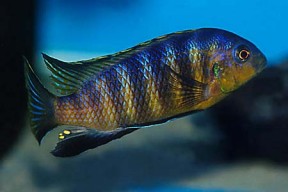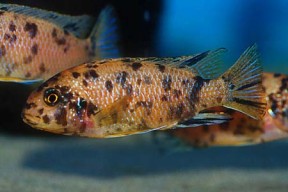Pseudotropheus tropheops tropheops
Classification
Cichlidae
Distribution
Endemic to Lake Malawi. It occurs between the Maleri Islands and Chinyamwezi Rocks.
Habitat
It inhabits rocky coastlines, island shores and reefs.
Maximum Standard Length
4-8″ (10-20cm) depending on colour form.
Aquarium SizeTop ↑
48″ x 15″ x 12″ (120cm x 37.5cm x 30cm) – 135 litres, although larger is preferable.
Maintenance
Use piles of rockwork to form many cave-like structures and hiding places, interspersed with open areas for swimming. The best substrate for this species is sand.
Water Conditions
Temperature: 75-82°F (24-28°C)
pH: 7.6-8.8
Hardness: 10-25°H
Diet
It will accept most foods offered but vegetable matter in the form of spirulina flakes, blanched spinach, nori etc. should form a large proportion of the diet. This can be supplemented with live and frozen varieties. Never feed beefheart or any other animal meat as it interferes with the digestive system of these fish.
Behaviour and CompatibilityTop ↑
Not especially aggressive for a mbuna, although it is quite robust. It should not be kept with peace loving species such as Peacocks or Utaka but it can be combined with other similarly sized mbuna. The tank should be overcrowded to reduce aggression and territory formation. Several females should be kept per male in order to reduce harassment by the male. Only one male should be kept unless the tank is very large.
Sexual Dimorphism
Females are usually smaller and less colourful than males.
Reproduction
Possible. Maternal mouthbrooder. Ideally, it should be spawned in a species tank in a harem of one male and at least 3 females, although it will often spawn in the community aquarium. A 48″ aquarium is a good size (although larger is preferable) and this should be furnished as suggested above Some flat rocks and areas of open substrate to act as potential spawning sites should also be provided. The pH should be around 8.2-8.5 and the temperature 77-80°F. Condition the fish with a high quality diet composed mainly of vegetable matter.
The male fish will clean and then display around his chosen spawning site. This may be a flat rock surface, or a shallow pit which he excavates in the substrate. He will show intense colour and will attempt to entice females to mate with him. He is quite vigorous in his pursuits and it is in order to dissipate this aggression that this species should be spawned in a harem. When a female is willing, she will approach the spawning site and lay her eggs there, after which she picks them up in her mouth. The male fish has egg-shaped spots on his anal fin and the female is attracted to these. When she tries to add them to the brood in her mouth, she actually recieves milt from the male, thus fertilising the eggs.
The female will carry the eggs for around 3-4 weeks before releasing the free swimming fry. She will not eat during this period and can be easily spotted by her distended mouth. If a female is overly stressed, she may spit out the brood prematurely or eat them. Care must be taken if you decide to move the fish in order to avoid fry predation or harassment by the males. It is also worth noting that if a female is away from the colony for too long she may lose her position in the pecking order of the group. Some breeders artificially strip the fry from the mother’s mouth at the 2 week stage and raise them from that point as this usually results in a larger number of fry.
The fry are large enough to take brine shrimp nauplii, microworm and powdered dried foods from birth.
This breeding account is for P. t. tropheops, but it should be noted that some of its morphs (which are most likely different species) breed in caves excavated by the male. Mouth-brooding by the female is as described above.
NotesTop ↑
This species has a confusing taxonomic past. There are currently 3 subspecies, Pseudotropheus tropheops tropheops, P. t. romandi and P. t. gracilior. P. macrophthalmus and P. microstoma were also once considered as subspecies of tropheops, but are now classed as distinct species. Furthermore, it is likely that the current subspecies and their various colour forms (of which there are many) will be themselves reclassifed into the currently invalid genus Tropheops! Incidentally, none of the subspecies or their morphs should be mixed in aquaria as they will hybridise.
P. t. tropheops. exhibits a characteristic swimming angle of around 45° when it is browsing for food and has a mouth designed specifically to feed in this way. It is well-suited to most mbuna communities, being relatively peaceable but able to stand up for itself.



